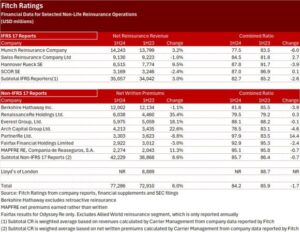Fitch Ratings recently released its midyear 2024 report on the underwriting results of 19 non-life reinsurers, revealing an average combined ratio of 84.2% for the first half of the year. This strong performance signals continued profitability for reinsurers in the latter half of 2024 and into 2025. However, Fitch analysts caution that profit margins will likely peak this year, despite the favorable returns expected next year.
Sustained Profitability, but Margins Peak in 2024
The report predicts that reinsurers will maintain their underwriting discipline and achieve solid returns in 2025. However, the profit margins seen in 2024 are expected to be the high point, largely due to a balance in market supply and demand.
“Market conditions will remain favorable into 2025, supported by adequate rates and stable demand,” the Fitch report states. Net written premiums for non-life reinsurance increased by 6% in the first half of 2024 compared to the same period in 2023, driven by a strong reinsurance renewal season and favorable market conditions.

Slower Growth and Increased Competition Ahead
While the growth in premiums is expected to continue, the report notes that the pace will likely slow down as the market becomes more competitive. Fitch describes the current reinsurance market as having reached a point of equilibrium, where increased capital from earnings matches the rising demand for reinsurance protection.
Having reached this equilibrium, Fitch anticipates market rates will remain flat in 2025, with terms and conditions holding steady. This stability, coupled with limited new capacity entering the market, suggests a continuation of disciplined underwriting practices.
Challenges on the Horizon: Social Inflation and Climate Risk
Despite this favorable outlook, Fitch warns of potential risks that could impact the market, such as worsening U.S. casualty loss cost trends driven by social inflation, as well as increased exposure to catastrophe and climate change risks. The report highlights the challenges posed by these factors, which reinsurers must navigate carefully in the coming years.
Financial Performance Under IFRS 17 Standards
The report also highlights the financial results of four reinsurers adopting the new IFRS 17 accounting standard, showing their non-life reinsurance revenues instead of net written premiums. The combined ratio for these reinsurers, which includes the impact of discounting, has improved year-over-year.
For the group of 19 reinsurers, the aggregate combined ratio improved to 84.2% in the first half of 2024 from 85.9% in the same period in 2023. Catastrophe losses accounted for 5.9 points of the combined ratio, down from 6.9 points last year. Loss reserve development was slightly less favorable, shaving 2.8 points off the combined ratio, compared to 3.3 points in 2023.

Varying Results Among Reinsurers
While the industry saw overall growth, individual reinsurers experienced differing results. RenaissanceRe, for instance, posted a 35% increase in net written premiums for the first half of 2024, largely due to its acquisition of Validus Holdings in late 2023. Other major players like Everest and Arch Capital also saw premium growth of around 20%.
Conversely, several reinsurers, including PartnerRe, AXIS Capital, and SiriusPoint, reported declines in premiums. PartnerRe’s combined ratio rose sharply by 14.4 points, reaching 97.9%, while SiriusPoint saw a 13.9-point increase, reaching 87.3% for the same period.
Mergers, Acquisitions, and Alternative Capital
Looking forward, the report discusses the potential for mergers and acquisitions in the reinsurance sector as organic growth opportunities slow. Alternative reinsurance capital is expected to continue growing, barring major catastrophe losses in the second half of 2024.
Fitch’s analysis also reveals that the 19 reinsurers achieved an average return on equity (ROE) of 19.9% in the first half of 2024, slightly down from the 20.1% ROE recorded in the same period last year. The only company to report a net loss was SCOR SE, due to a charge in its life-health business, but the broader industry saw solid underwriting gains and positive investment returns, supported by strong equity markets and higher reinvestment yields.
As reinsurers navigate an increasingly competitive landscape, their ability to balance disciplined underwriting with emerging risks will be critical for maintaining profitability in the coming years.

